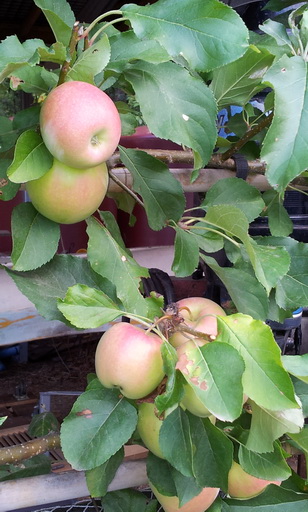Adapted from information written by DENNIS TING, Fruit Tree Specialist at Gardenworld Nursery.
Advantages of smaller or dwarf trees
A smaller tree is generally easier to maintain in terms of pruning, spraying, protecting from birds and netting and harvesting without the need for ladders or extended pruning equipment.
You can also grow more varieties in the same space, an important consideration for when you need pollinating partners or just want some variety in your fruit repertoire, e.g. apples, pears, plums with early, mid, and late harvest potential.
Many fruit trees can cope with being in containers too, an important consideration especially if you are battling poor or badly draining soils, e.g. citrus trees.
Space Saving Techniques
In the past the way to control the size of large trees has been mainly by continued hacking of branches in an attempt to make some of the high and best fruit within reach. Far better to plant, where possible, some form of dwarf fruit tree or use some sort of root restriction to keep tree size smaller.
Dwarf Rootstocks
Many fruit trees are grafted onto rootstock for different reasons, usually amounting to increased vigour for the tree and earlier fruiting. It also guarantees that the fruit grows true to type, which is never guaranteed when fruit is grown from a sprouting seed. Nowadays, rootstock is also chosen that will keep the eventual size of the tree to a more manageable size in response to smaller gardens. Recently, for example, new dwarfing rootstocks have been imported for Apricots, Plums and Cherries allowing traditional varieties to be kept to 2 metres or less compared to 4 to 6 metres in a standard tree.
Self-pollinating Trees
Keep in mind that some fruit trees require cross pollination from flowers of another variety of the same fruit (e.g. apples, pears and plums), while others are self-pollinating (e.g. peaches and nectarines) but still do better with other varieties about. If your neighbours have a pollinating partner to your trees, you can take advantage of this otherwise you will need to plant another tree.
Multiple Planting
The problem with needing a pollinating partner in limited space can be overcome by using the technique of multiple planting. Here planting two, three or even four varieties of trees of the same type (e.g. varieties of apples) in the same planting hole, about 45cm apart, will restrict the growth of the trees, while providing pollinating partners for each other.
Multi-Graft Fruit Trees
In this case you have up to 4 different varieties of one tree grafted onto the one trunk. Each branch will provide pollinating partners for each other; or in the case of peaches or nectarines which don’t need partners, extends the harvest of the fruit as some will be earlier and some later fruiting, a bonus for the home gardener. The main disadvantage of this system is that some branches may grow more vigorously than others, leaving one variety or another weaker and less productive.
Espalier
This fashionable, two-dimensional space-saving technique can be used with most fruit trees though you need to start work on the espalier shape while the tree is still young and its growth supple. Espaliered fruit trees also have the benefit of being able to cover up boring and unsightly fences with delicious fruit! Trees can be espaliered into different forms, including fan-shaped, horizontally, candelabra and even random shapes. The important thing here is to be active in its training as the trees have a tendency to want to grow in more than 2-dimensions!
Container Growing
This is best suited to trees grafted onto dwarf rootstock and both traditional pip & stone fruit and especially citrus are suitable. Choose a container which is of a light colour like ‘terracotta’ (not black) whether plastic or terracotta material so it will not heat up in the sun. When planting into a container, don’t be tempted to put your tree straight into a much larger pot than the one it has come in. It is far better to re-pot every couple of years into the next-sized pot. This ensures denser root development and stronger growth. If you are into the final pot, then take the tree out and do a root-prune every few years when the tree is dormant and put in some fresh top quality potting mix. Trees in pots need you to take better care of their needs than when in-ground, so regular watering, especially over summer is essential as is the feeding regime. Mulching with a straw-based, light coloured mulch is also helpful.
---------------------------------------------------------------------------------------------------------------------
Some final notes from Dennis
One area that causes confusion is the following:
Newer rootstocks have been released with traditional varieties grafted on to them e.g. dwarf Apricot rootstock with traditional varieties such as Moorpark or Trevatt; dwarf Plums with varieties such as Mariposa and Santa Rosa, produce true to type full size fruit. Apples such as Pinkabelle (= Pink Lady) and Leprechaun (= Granny Smith) grow true to type full sized apples on dwarf trees. All Citrus on dwarf rootstock grow true to type.
This is in comparison to many so called ‘dwarfs’ e.g. peaches – Pixzee, Red Leafed Peach where the fruit may not be like a traditional fruit or Ballerina Apples as in these cases the fruit will be different from standard varieties.
